December 2, 2012 at 9:28 pm
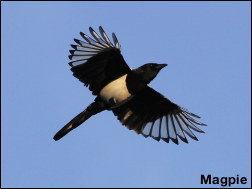
This Magpie was seen to take a Waxwing from the flock at Hulme this week. Always an opportunist feeder it made a quick move and sadly there was one less of my favourite birds to savour. Having said that at 8.15am on the 28th November there was an incredible 230 Waxwings present in one tree. Whilst spending hours during the week in Hulme I was amazed at the other birds that inhabit the estate. A female Sparrowhawk was always a threat, fourteen Long Tailed Tits fed in the gardens plus a wintering male Blackcap that was devouring the heavy crop of berries of a privet.
The highlight of the week was the return to the garden of the Willow Tit for the sixth Winter in a row. Where it goes for the rest of the year is a mystery. In addition on five days we had more than twenty species feeding,, peaking at a near record of twenty three species on the 2nd December, thanks to the re-appearing Willow Tit. On the canal nearby we also had a pair of Goosanders at dawn.
A drive to Wetherby on 2nd December produced sightings of five, Kestrels, four Buzzards and a Kite. Good to see the Kestrel was back on top.
November 26, 2012 at 6:32 am
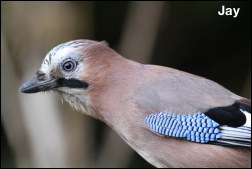 That’s the number of Waxwings in one tree at 8.30am in Hulme, South Manchester on the 24th. Its the largest number of Waxwings that I have seen since the big invasion of 1996 when more than 300 were present in Stockport. I spent nearly an hour watching them feed on a white berried Rowan and it would have been good to film but there was no light available.
That’s the number of Waxwings in one tree at 8.30am in Hulme, South Manchester on the 24th. Its the largest number of Waxwings that I have seen since the big invasion of 1996 when more than 300 were present in Stockport. I spent nearly an hour watching them feed on a white berried Rowan and it would have been good to film but there was no light available.
This weeks photo of a Jay shows what can happen when you are filming with fixed focal length lenses. I was set up in the garage hoping to film a Nuthatch at a range of only eight feet. When a Jay appeared it was a case of only head and shoulders with a 300m lens. For years I have used a zoom lens which would have easily coped with this situation. It just shows that by obtaining a better quality fixed lens other considerations come into play, such as image size.
On 21st November we had twenty one different species in the garden including eight Long Tailed Tits, two Goldcrest and a Reed Bunting. Whilst there are more birds beginning to feed we still have only a handful of Goldfinches feeding and one male Bullfinch. Perhaps when the snow comes we will see an increase?
My latest DVD ‘A Bird for All Seasons’ is now available to purchase through my website.
November 18, 2012 at 8:43 pm
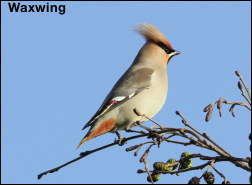
The Waxwing invasion is now under way. Well, in some parts of Manchester it is but a daily search of the thirty Rowan trees that I monitor in the Rochdale, Oldham, Middleton area has produced no Waxwings. In fact there were only three trees with berries on and most of those have been eaten by Mistle Thrushes. I therefore decided to check some Rowans in Salford that were used by Waxwings in the 1996 invasion and I was not disappointed. Ninety Waxwings were feeding at 11am. With no other birders present it was ideal and I even had time to chat to a man walking a dog and tell him what they were. He was quite interested until I noticed his dog was lubricating my expensive photo trekker that was lying on the grass. End of conversation!
On Hopwood during the week two more Woodcock were present together with the regular Green Woodpeckers. On two occasions a Dipper has been making territorial song flights along part of the stream.
In the garden on the eleventh of November we had a near record twenty two different species feeding during the day.
I promised the Macclesfield RSPB group that I would post on my blog page what I used to combat midges in Scotland . Since talking to two fishermen on Islay a few years ago I have been using a product from Avon. It is a dry oil body spray from their Skin So Soft range, it has nothing to do with midges but like the fishermen I find it very effective.
November 11, 2012 at 6:45 pm
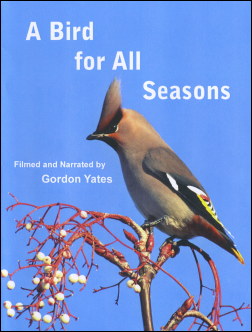
Seven years of filming and four months of editing have been completed and the new DVD is now available.
The lives of eighty species of birds are shown through one of the harshest Winters ever recorded followed by one of the wettest Summers. Some birds, like Hawfinch and Nightjar, I have never filmed before while others are performing tasks that have rarely been captured on film. Included in this category are a Buzzard feeding an Adder to its young, a Green Woodpecker digging a hole in a living Oak tree, a Woodcock with four newly hatched young and best of all a female Barn Owl, nesting on the ground, with the young resting on her back.
With a running time of sixty three minutes it is the longest of our five DVDs and the last one planned. How appropriate that my favourite bird, the Waxwing, graces the front cover at a time when we are awaiting a huge influx from Scandinavia.
Copies of the DVD may either be obtained by either phoning me on 01706 631770 or emailing me at
wildlife@gordon-yates.com The price is £15 plus £1 P&P. The DVD will be available through my website in a couple of weeks
November 4, 2012 at 7:35 pm
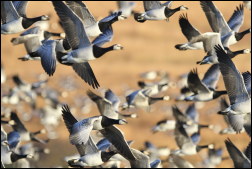
I couldn’t resist including a last photo of Barnacle Geese taking off from their feeding ground on Islay. One week is never long enough on Islay and now that we are back home I find that there are Waxwings all over the island. My favourite bird and I have missed them by a week – let’s hope they make their way down here to liven up our Winter.
On Hopwood on the thirty first of October two Woodcock were resting, only a foot apart, at a place they always visit each Winter. If we have a severe Winter there may be a chance of baiting them with a regular supply of maggots. It is a great challenge and they are the only birds I have never filmed locally in Winter. Many long hours would have to be spent in a hide, entering it in the dark and hoping a bird would feed in front of it when it became light. I must admit I am not as enthusiastic about this challenge today as I would have been thirty years ago!.
In the garden on the third of November we had twenty different species feeding for the first time since last Winter. There was a welcome return of a Song Thrush, Bullfinch and Starling and we await with anticipation for what the rest of Winter will bring.
October 28, 2012 at 9:42 pm
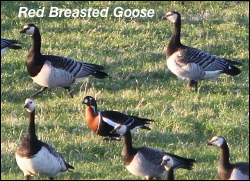
There is little doubt that one of the greatest bird spectacles in Europe in Autumn occurs on Islay as 50,000 Geese arrive from their breeding grounds in the Arctic. Added to that the sight of more than 100 Whooper Swans in one field is another spectacle not to be missed.
Autumn is a time when birds are on the move and while watching the Geese arrive from the North other birds like Swallows, Whinchat and Wheatear are starting their journeys to the South. This year the Geese have brought a very special bird with them from Russia in the form of a Red Breasted Goose. Although more than four hundred yards away at the time I managed to take a still photo which shows it to be smaller than the Barnacle Geese which it associates with.
Islay is famous for its Raptors and although we failed to see any Eagles last week many other birders on the island were successful. We did, however, see many Hen Harriers and one morning saw six different species of raptor in less than two hours.
Not many visitors to Islay come for flowers in the last week of October but during our week we have found sixty two flowering plants. Included in this total have been Autumn Gentian, Pansy and even a Bluebell!







